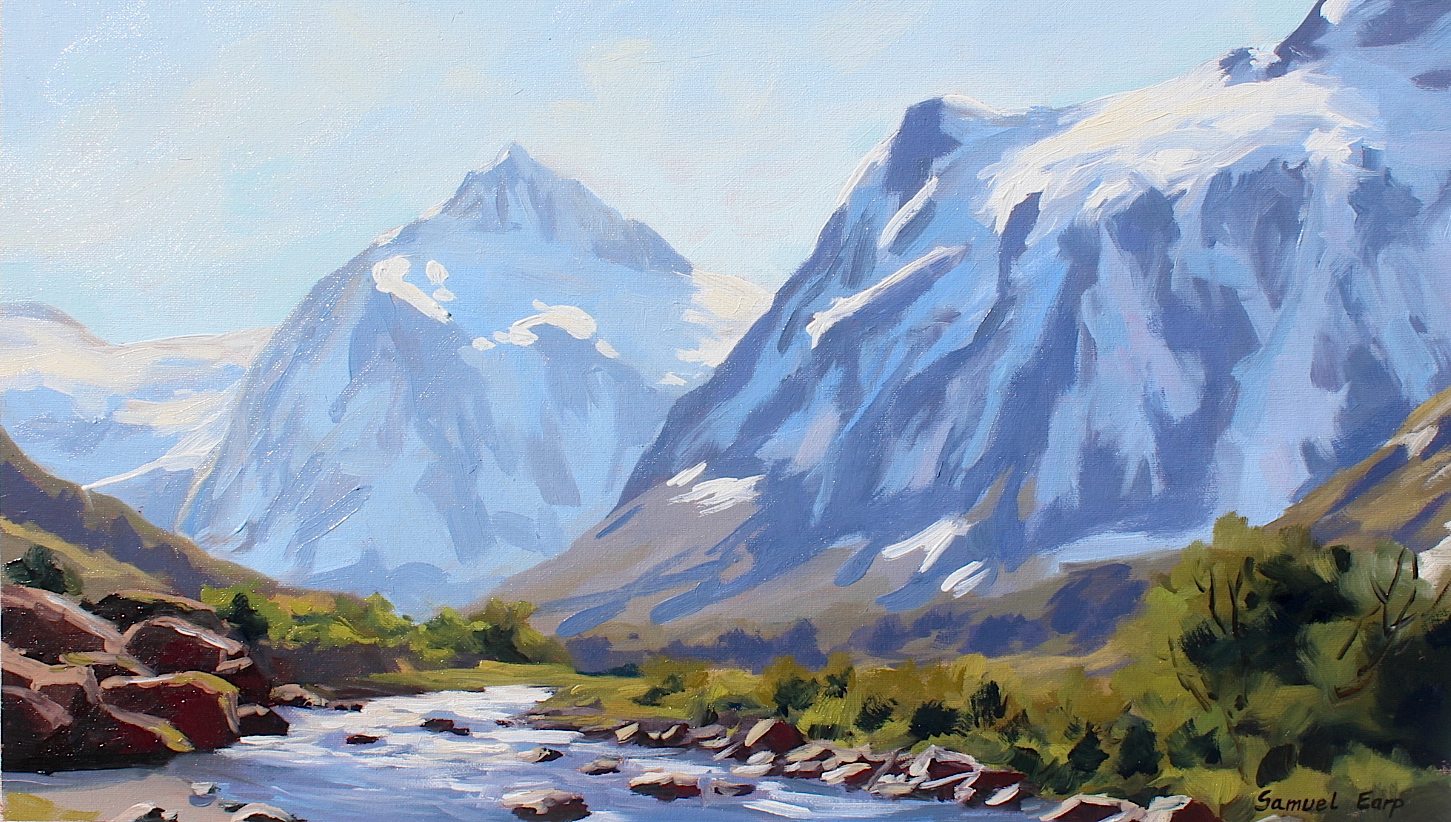
I love landscape art, especially traditional realism painting and I have been painting landscapes for many years. Whilst I paint a lot in my studio one of the things I love to do is paint outside on location in the great outdoors. This is called painting ‘en plein air’, which is a French phrase meaning to ‘paint outdoors’. Plein air painting is not only thoroughly enjoyable, and great for the mind, body and spirit, but it also helps immensely with improving your studio work.
Plein air painting teaches you to really look at the landscape, its forms, colours and tonality. It teaches you to loosen up your painting technique, improves your use of colour and understanding of composition. It also teaches you to paint quickly as the light and weather conditions are always changing.
One of the other rewarding things about plein air painting is that within a few hours you can create some beautiful, masterpieces that would be suitable to hang on a living room wall. Plein air paintings are vibrant and alive and often much more atmospheric and magical than studio paintings.
In this article I am going to explain some of the equipment you will need for painting outdoors and I’ll briefly go over some of the gear I use. I have also included a step by step plein air painting demonstration that will give you some tips on how to approach painting a landscape from life. Many of the principles required for plein air painting can be applied to your studio art work. So readers, pick up your brushes and paints and have a go at painting outdoors, I guarantee you’ll have loads of fun and your paintings will improve dramatically.
If you like this article, please subscribe to my mailing list or you can follow me on social media by clicking the icons below.
Equipment
The first time I ever went plein air painting I brought my studio easel, I quickly found that it was cumbersome to carry around with me, although it was fine to use for the first couple of times. However, I decided to purchase some equipment that would make my plein air painting experience much easier. One of my main items of equipment I use for plein air painting is my pochade box (pictured below). This is a portable easel that contains storage compartments for paints and finished paintings as well as a built in paint palette. My pochade box mounts on a standard camera tripod, making it sturdy for when I am painting and it is easy to carry around. There are many pochade box’s available on the market.
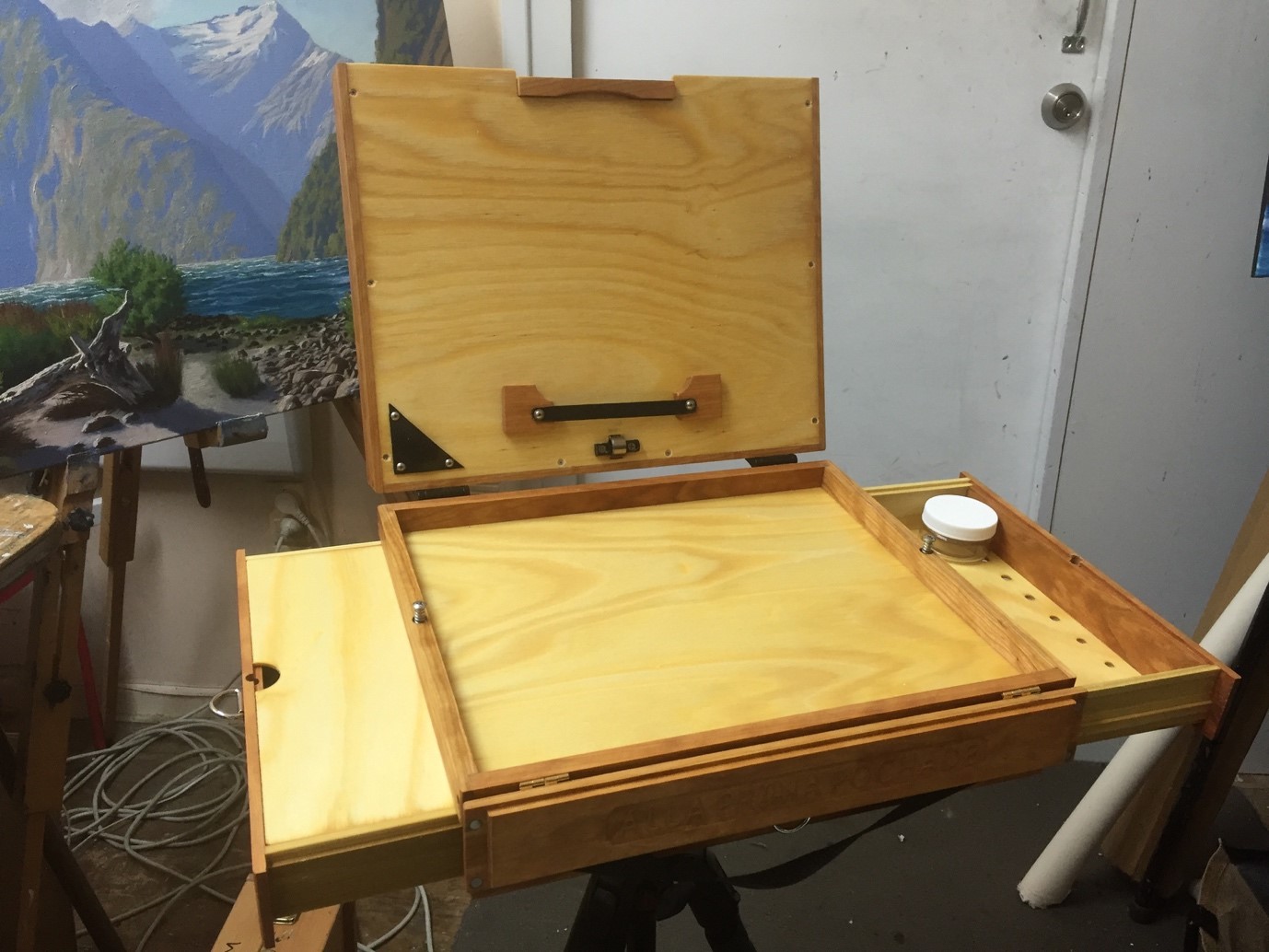
When plein air painting, many plein air artists including myself prefer to paint on loose canvas that is adhered to a panel with masking tape. This allows the artist to paint whatever size canvas they desire and it is also a cheaper way of doing it especially when you’re learning and getting to grips with painting outside. The finished painting can then be either mounted on a board or stretcher bars. Note: if you intend to mount the painting on stretcher bars it is advisable to adjust your canvas size to standard sizes and leave at least 3cm edge so it can be comfortably mounted on stretcher bars.

The equipment I use for plein air painting includes the following:
- Pochade box
- Camera tripod
- Paints
- Brushes
- Brush cleaner
- Liquin
- Paper towels
- Cloth
- Disposable nitrile gloves
Painting Demonstration – Painting Mt Talbot
One of my favorite subjects to paint is Mt Talbot in Fiordland, New Zealand. The mountains in this area are rugged, majestic and beautiful and their forms make it relatively easy to compile dramatic and engaging compositions.
If you have never done plein air painting before, it can be helpful to have a go at painting in a plein air style in your studio first of all. Please feel free to use and have a go at painting the image below.
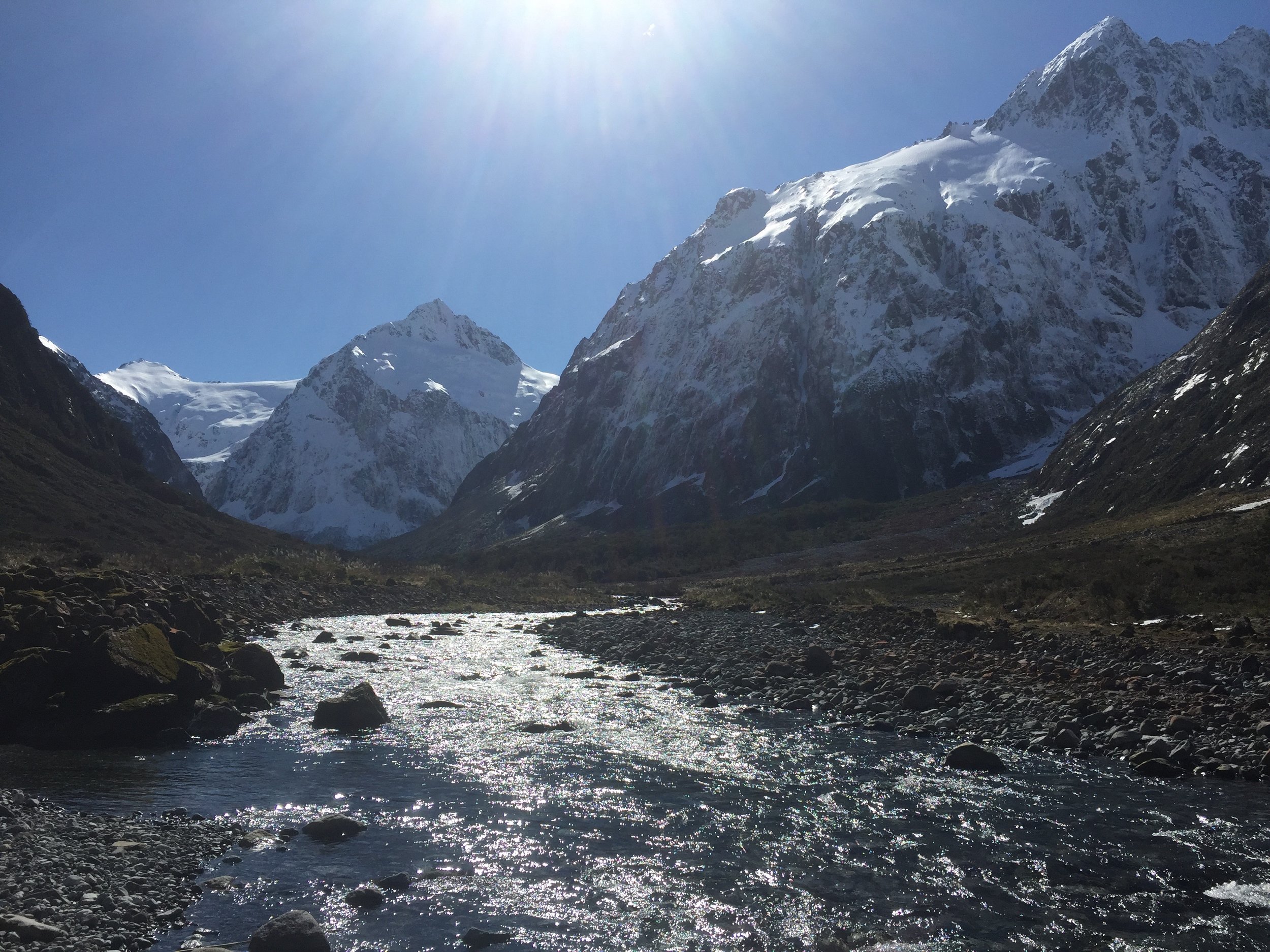
My Colour Palette
I painted this artwork using oil paint and the colours I used in this painting are as follows:
- Titanium white
- Cadmium yellow deep
- Yellow oxide
- Burnt sienna
- Burnt umber
- Cadmium red light
- Quinacridone magenta
- Ultramarine blue
- Cobalt blue
- Cobalt teal
- Pthalo green
Choosing your subject
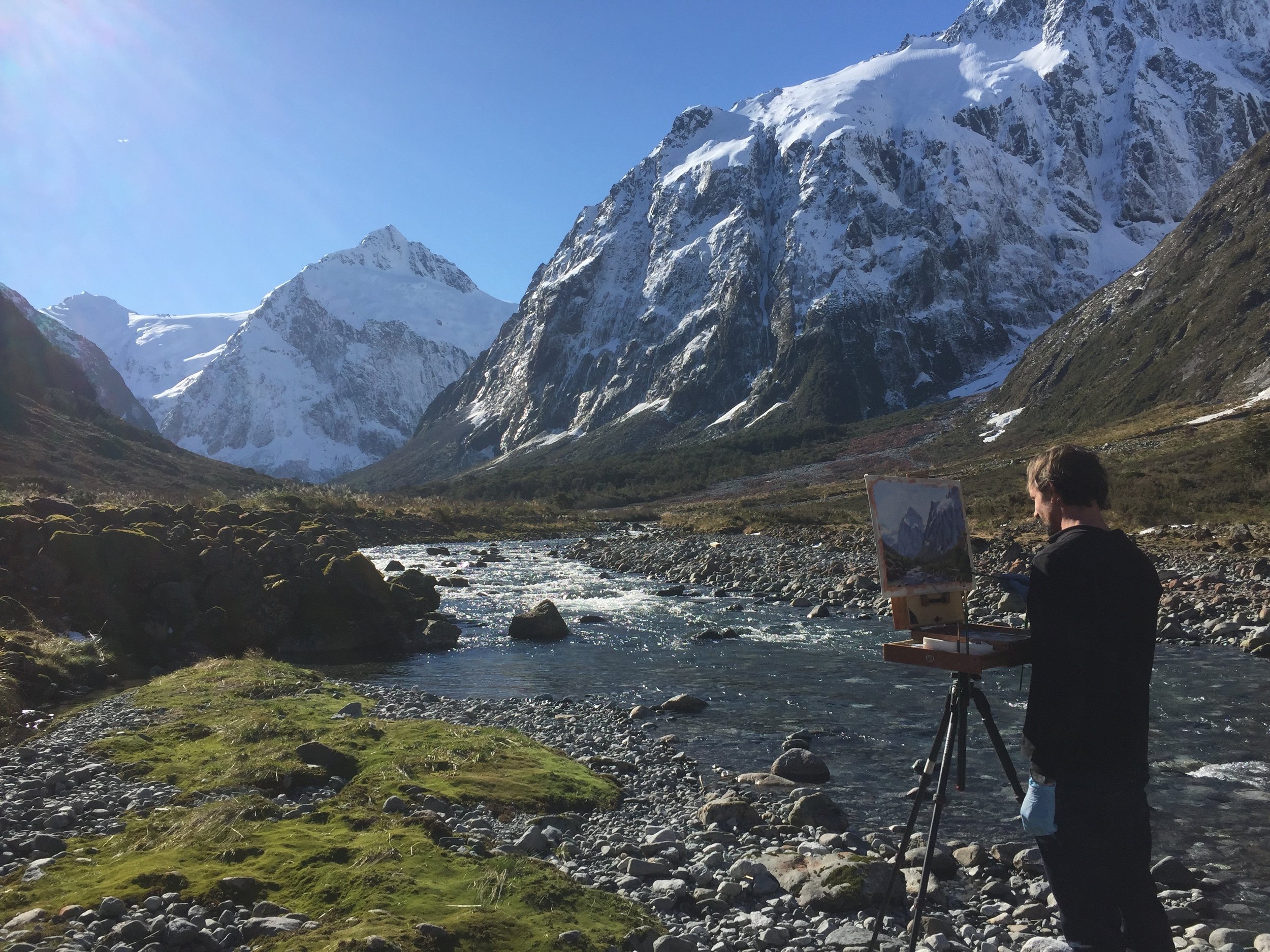
When painting mountains or indeed any landscape en plein air, I feel it’s best to simplify the subject. It is important to not only establish a good composition but to be mindful of where the light source is coming from and how it interacts with the landscape as this will help to make an engaging painting. This scene is particularly good to paint as there is strong contrast between light and dark values.
Landscape paintings are always more dramatic and interesting if there are a range of highlights and shadows and variation in tonality. When painting en plein air, it is helpful to squint your eyes, which removes some of the colour and makes lights and darks in the landscape more obvious. This is hugely helpful in establishing tonal values in your painting.
Mountains are an attractive subject to paint, the feeling of great height, elevations, high ground and physical shapes can make a very dramatic and beautiful painting. If mountains are the main subject of the painting, drama can be created by having a low horizon with the top contours of the mountains being placed near to the upper edge of the canvas. If appropriate to the harmony of the composition, the mountains can even go off the canvas.
When painting light on mountains they should be painted as such where they are either mostly in shadow or mostly in light as equal measures can be monotonous and hinder the composition.
In this scene I have made Mt Talbot my focal area. I have made a few alterations to the composition to make it a more harmonious and engaging painting. This included altering and moving the shape of the river and simplifying the elements in the foreground.
When painting en plein air, always turn your easel so it is in the shadow of the sun, this way it is easier to paint the subject and reduces the risk of making your painting tonally too dark.
Painting Mt Talbot – Step by Step Guide
Step 1
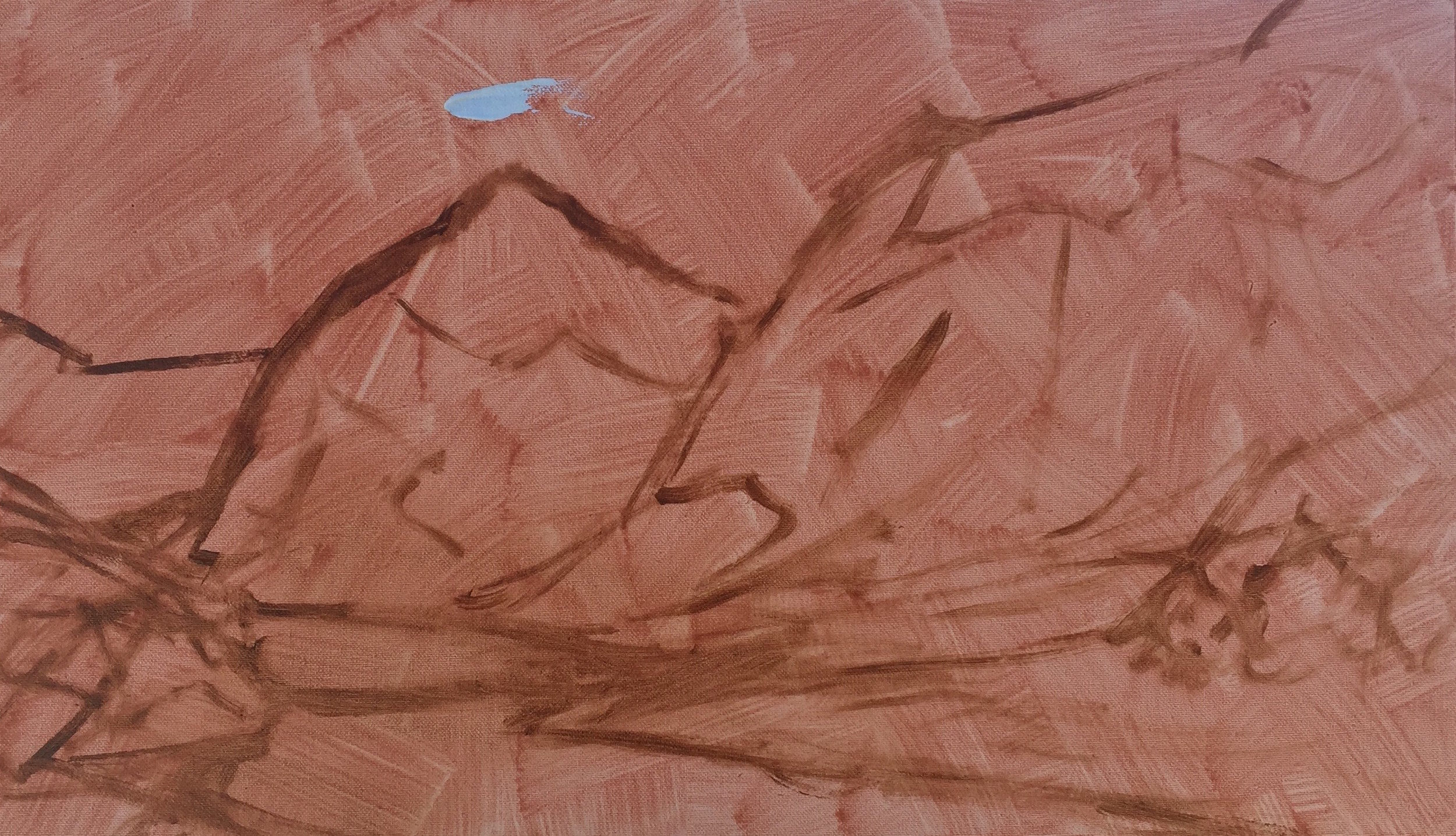
When painting outdoors or indeed even in my studio I prepare my canvas first of all with a layer of burnt sienna. The burnt sienna layer adds a dimension to the painting and brings warmth through the paint, I find this particularly advantageous in plein air painting. I prepared this in the studio prior to going out on location by mixing burnt sienna, liquin and thinners and then allowing a couple of days for it to dry.
I have sketched out the scene with burnt umber mixed with liquin.
Step 2
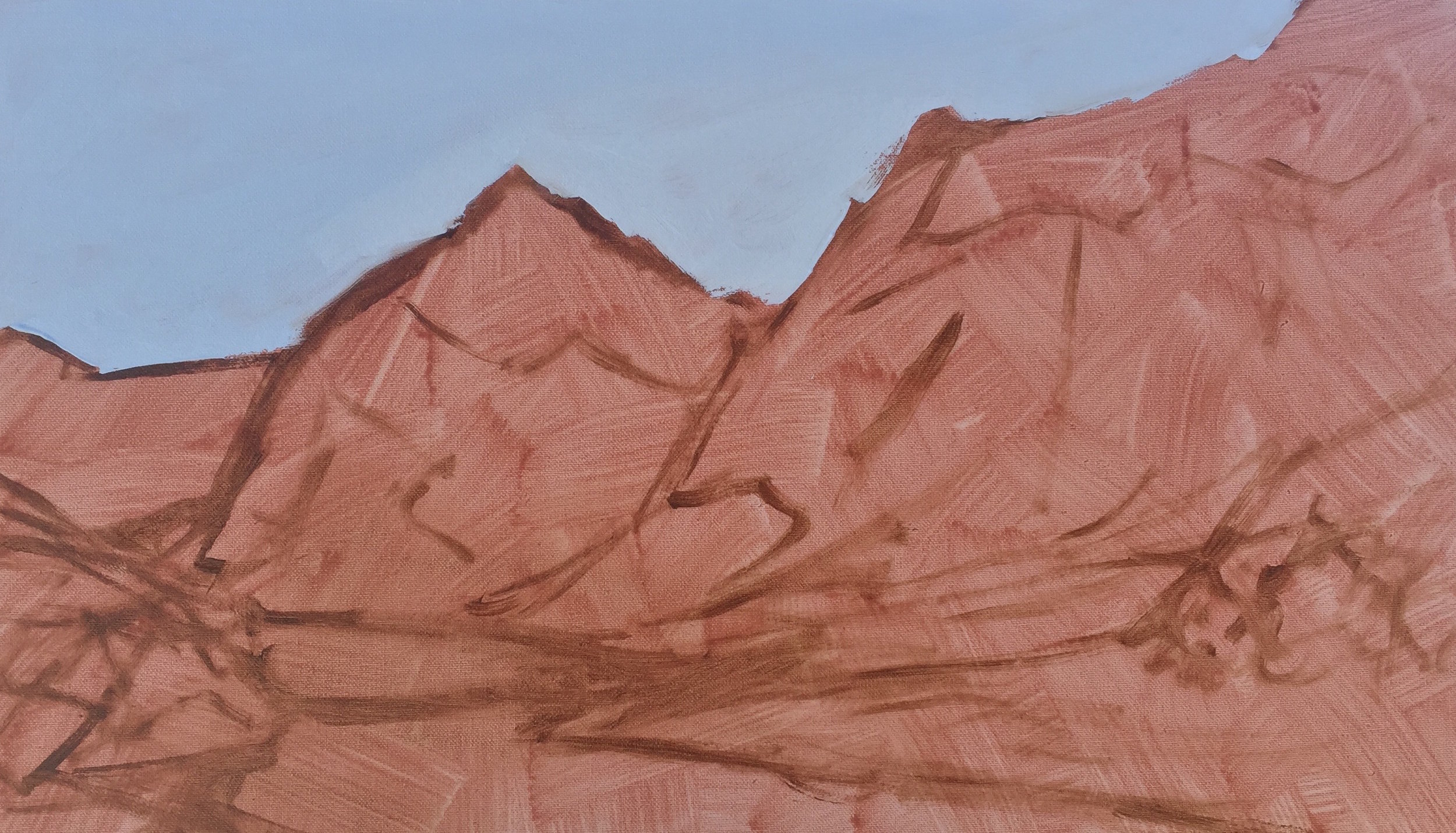
I have started painting the sky using a mixture of titanium white, cobalt blue and a little cobalt teal. Many plein air artists will start by painting the dark values first however I prefer to paint the sky first so I can then gauge the tonality of my painting from there. After painting the sky, I will then establish my most dark values immediately afterwards. I believe both methods are applicable. Either way it’s definitely best to get your darks in as quickly as possible, as then it won’t matter so much when the light changes or disappears in certain areas of the landscape you are painting.
Step 3
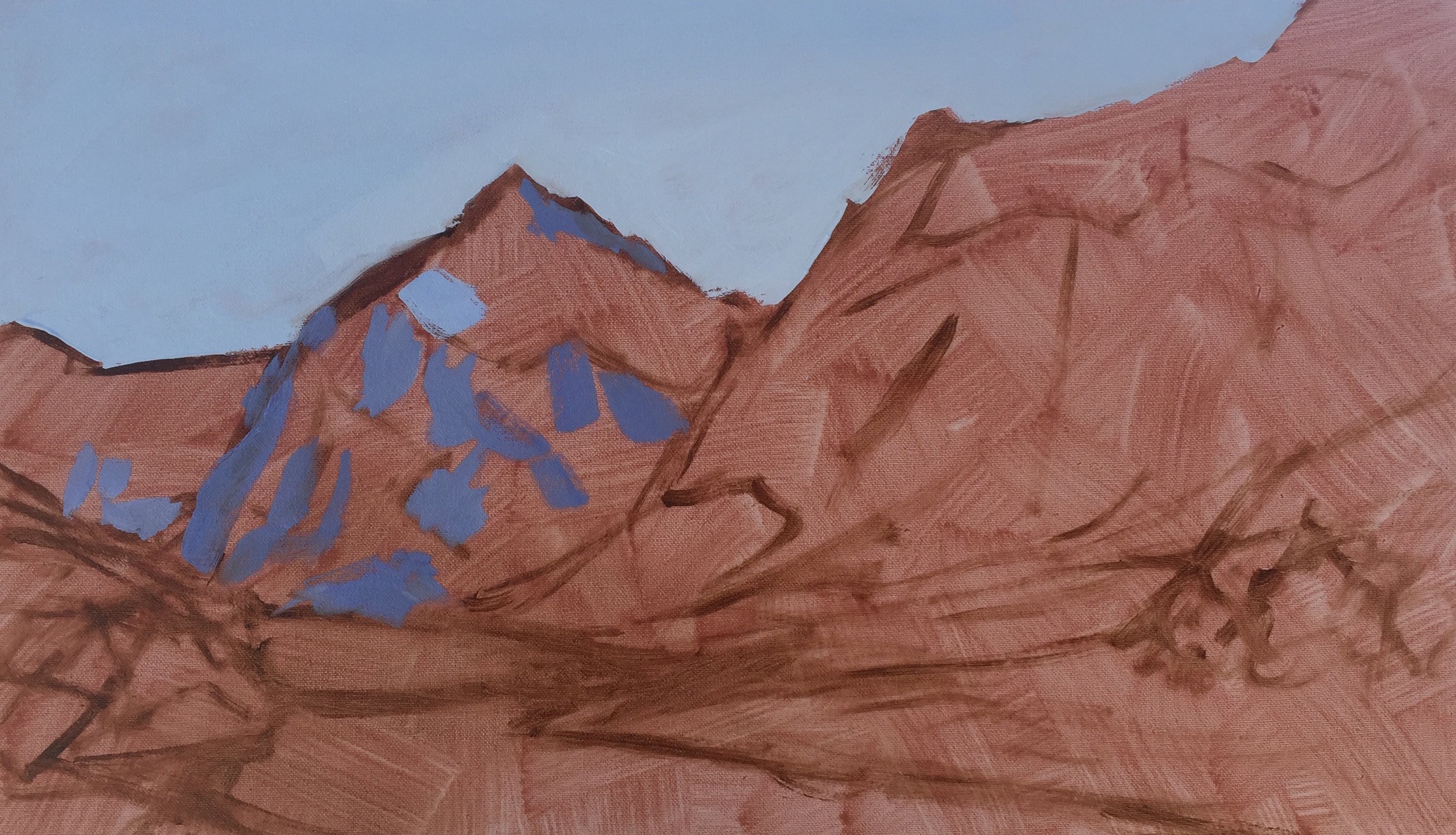
Painting quickly and using a large flat bristle brush, I start painting the shadow areas of Mt Talbot but bearing in mind the I need to keep the overall tone of the mountain lighter to create the perception of distance. The range of lights and darks is much narrower at this distance, meaning the shadows will lack the darkness compared with shadows in the foreground.
I’m using a trio of what I consider base colours that I use in landscape painting. These colours include, ultramarine blue, burnt umber and quinacridone magenta. I start with ultramarine blue and mix it with titanium white until I roughly have the desired tone. I then add a small amount of burnt umber to knock out some of the saturation of the blue and I then add a little quinacridone magenta to give it a violet tint.
Step 4
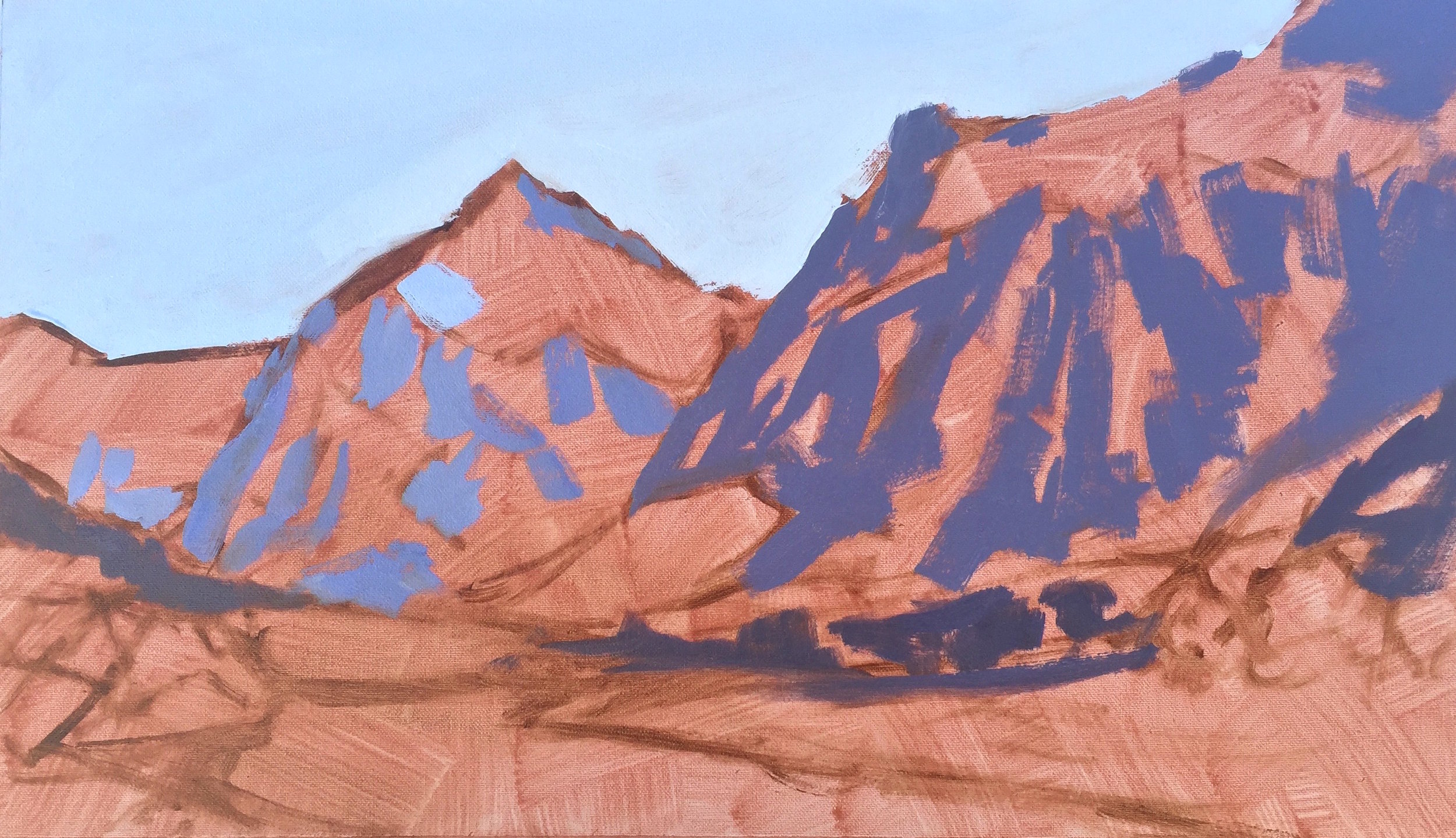
Next I darken the tone of the shadow areas of the large mountain on the right in the mid ground. I have used the same trio of colours, ultramarine blue, burnt umber and quinacridone magenta, as I used for Mt Talbot but with less titanium white in the mix to make the values darker. I have used even darker values of the same colour mix in the trees beneath the mountain.
When painting en plein air I am constantly thinking about the tonality of my painting and I keep in mind that as elements in the painting get nearer to where I am standing that darks get darker and the lights get lighter as the tonal scale widens. The tones in the distance are closer together and lighter than the elements in the mid and foreground. As I mentioned earlier, squinting your eyes with help you to see tone in the landscape which can then be applied in your painting.
I want to get my range of darks and mid tones in as soon as I can saving my darkest tones for the foreground.
Steps 5

Next I have started to block in the snow that is in shadow on Mt Talbot. Again I am thinking about tonality and that my range of light and darks is much narrower for elements in the distance. Therefore I am using desaturated colour as I do not want the mountain to come forward which would make the painting look flat.
I have used ultramarine blue, cobalt blue, as little burnt umber to reduce the saturation of the blue and a liberal amount of titanium white.
Step 6
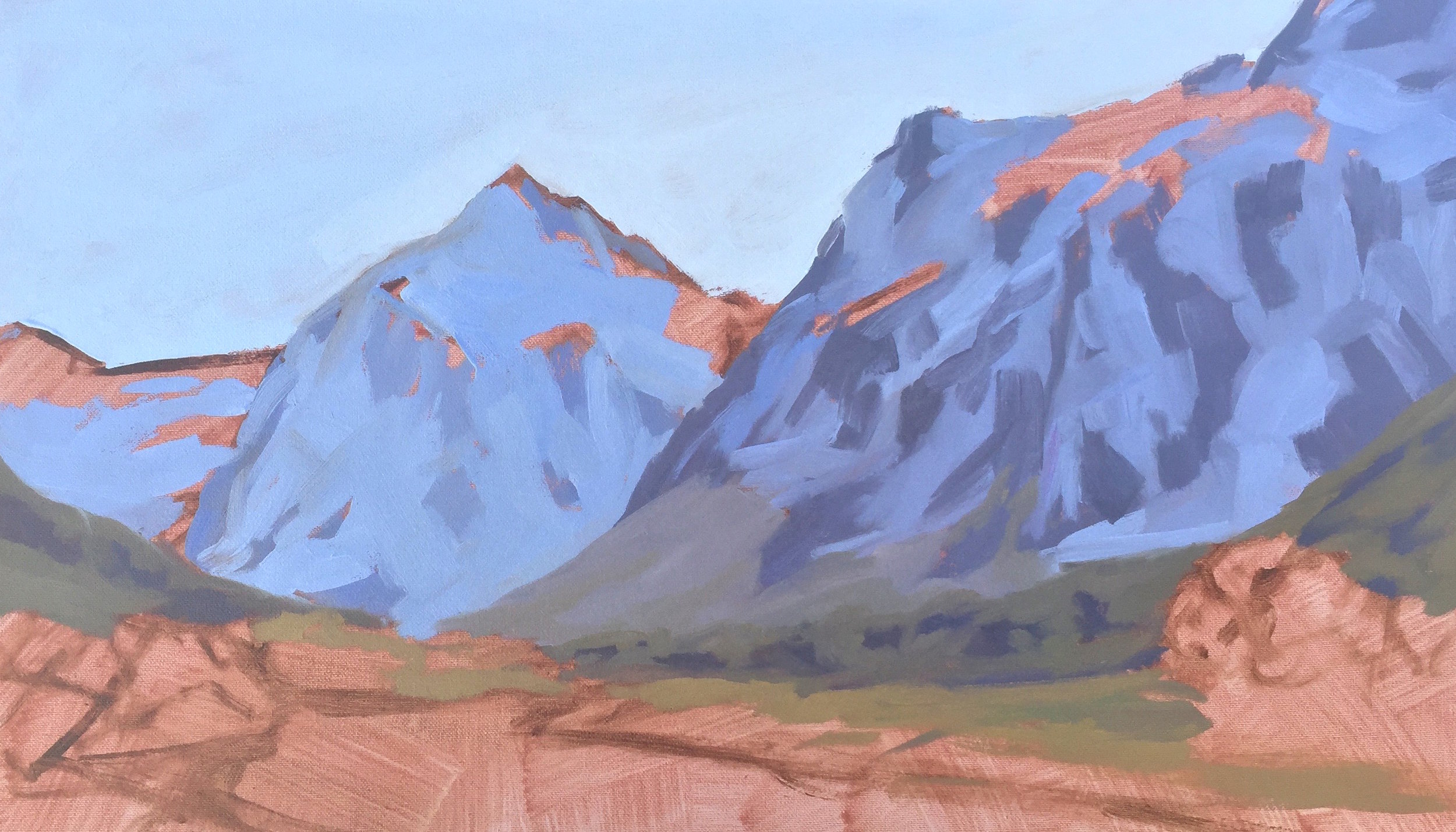
Here I am starting to get in the bulk of my colours in, painting quickly, I block in the large mountain on the right. The scree and vegetation in the distance requires desaturated colour, so I mix my trio of go to colours, ultramarine blue, quinacridone magenta, burnt umber and liberal amounts of titanium white. The green in mixed by introducing a little yellow oxide and more ultramarine blue, keeping in mind to keep it desaturated so it doesn’t come too far forward in the painting.
I increase the saturation of the colours in of the trees in the mid-ground, which brings them forward in the painting, but given the trees are in the mid-ground I need to be careful that my colours are not too saturated which would result in loss of depth.
In this particular scene I am hesitant about using any cadmium yellow for the mid-ground trees and foliage, so I mix yellow oxide with ultramarine blue, titanium white and a little burnt sienna to earth my greens to make it look more organic and natural.
Step 7
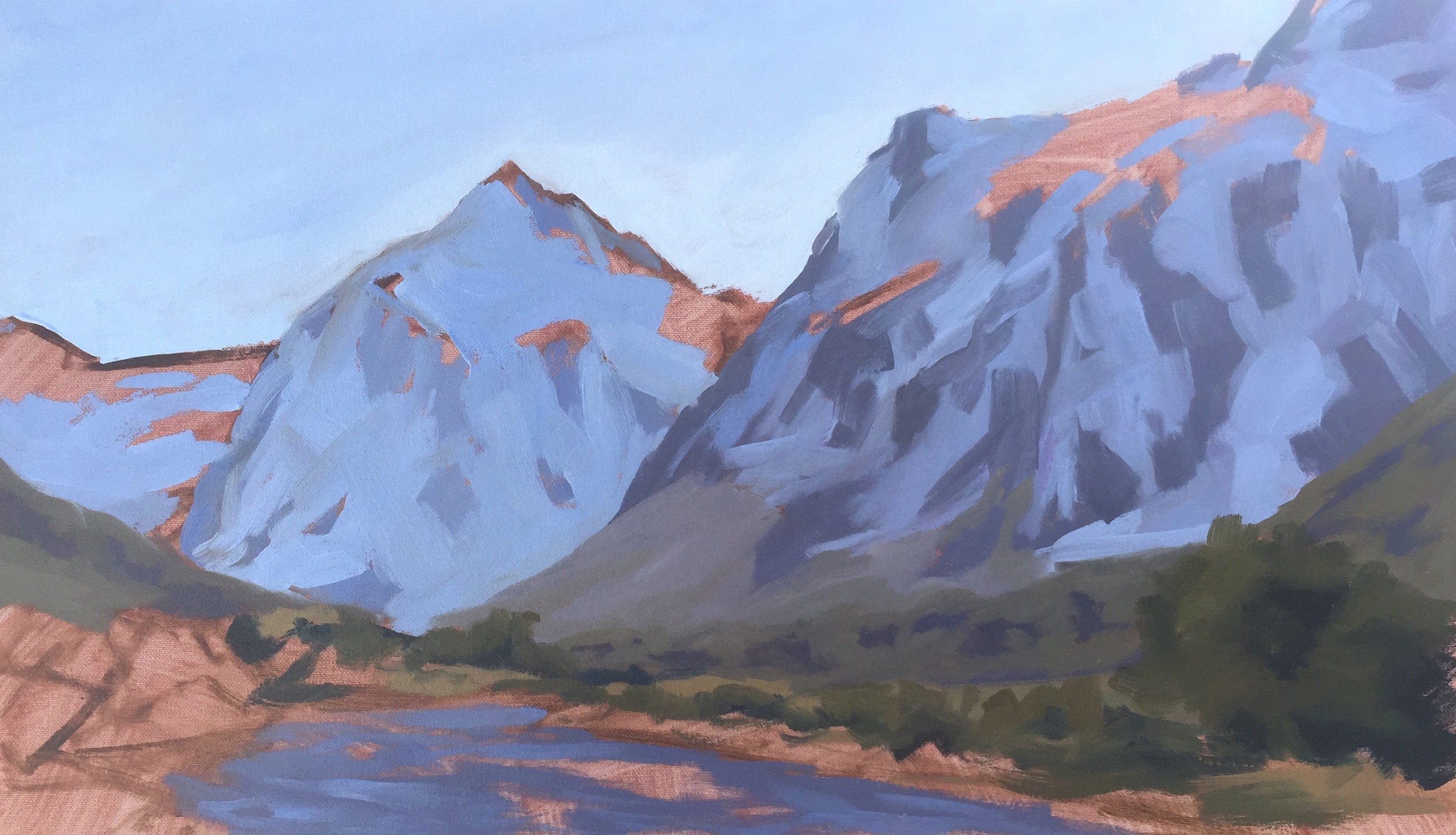
Now I am blocking in the foliage and bushes in the foreground and at the same time increasing the saturation of my colours. I mix different hues of greens by using varying amounts of cadmium yellow deep, ultramarine blue, pthalo green and quinacridone magenta.
The shadows in the trees was mixed using pthalo green and quinacridone magenta which creates a very dark tone as the two colours being near opposites on the colour wheel, cancel each other out. This colour mixes in well with the highlighted greens of the trees as they both contain the same colours as well as colours in the rest of the painting. Paintings are more harmonious when the colours contain common elements. If required I can also add burnt umber and/or ultramarine blue to create dark tones.
I also add burnt sienna or cadmium red light to my greens to create a variety of hues.
Be mindful that pthalo green is a very saturated green and therefore only a small amount is required. If used in excess, it can quickly overpower your colour mix. If too much pthalo green is added it can be nutralised with a little quinacridone magenta.
Step 8
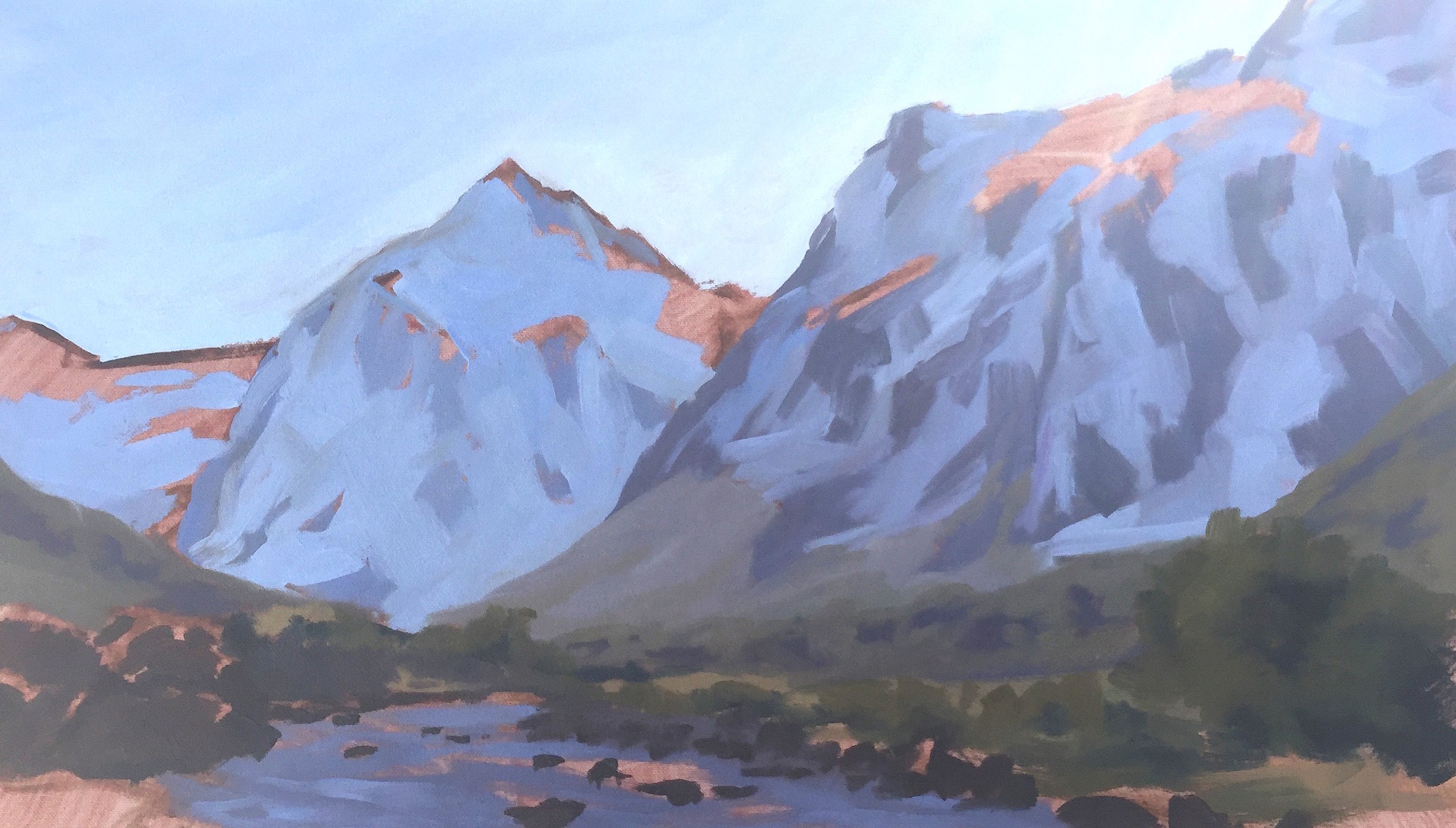
Next I am painting the rocks and boulders in the river. In order to create the effect of strong sunlight I am keeping the shadow areas dark. Effective landscape paintings are about relationships between light and dark values and where they are placed in the painting. I want to keep the shaded areas of the rocks dark so the highlighted areas are more effective and dramatic.
I have started painting in the river using cobalt blue and ultramarine blue mixed with titanium white and generally matching the colours contained in the sky. I have left a few gaps to add in white water.
Step 9
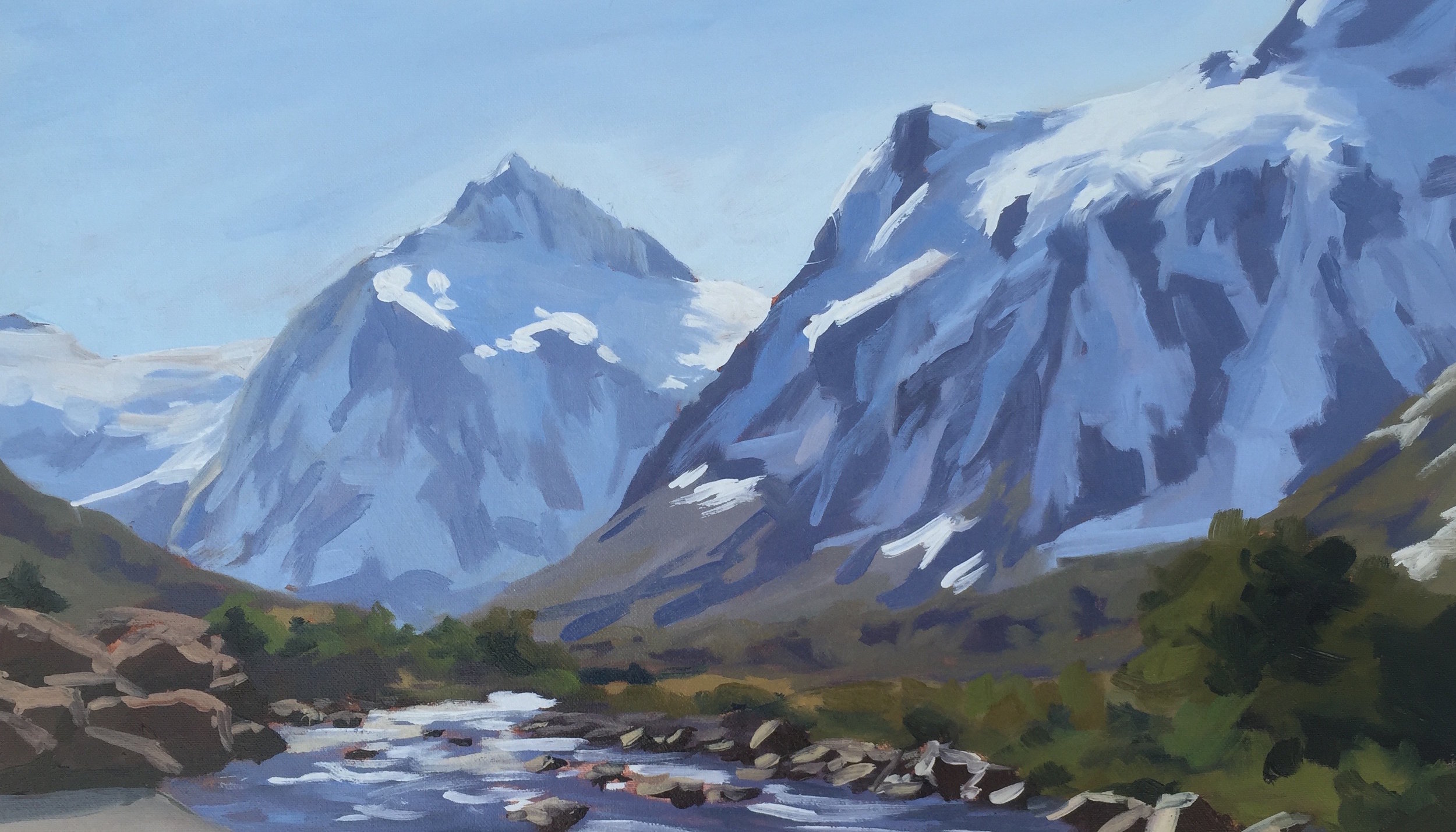
Now the fun part, adding the lighter tones that will bring the painting to life. I start to paint the highlighted snow on Mt Talbot by mixing titanium white and little yellow oxide. It’s always a good idea to add a little yellow oxide as titanium white on its own is too cold.
For the mountain furthest away on the left, I have added a little burnt umber to the snow to make it recede more.
I have used titanium white on the large mountain and allowed it to mix in a little with the existing colours I have used in the shadow snow areas. Afterwards I then go over the top of the snow with titanium white mixed with yellow oxide.
I have painted the highlights on the rocks using yellow oxide, mixed with burnt umber, burnt sienna and titanium white. I vary the mixture to create different hues.
I have added more foliage using varying hues of green which I mixed from cadmium yellow deep, ultramarine blue, pthalo green and adding other earth colours such as burnt sienna, cadmium red light and quinacridone magenta.
Step 10 – (Final Step)

This is where I finesse the painting, adding in twigs and branches to the trees, painting reflected light in the snow and adding the suggestion of cloud in the sky which adds interest and atmosphere in the painting.
Using liquin as a medium to mix and thin oil paints when plein air painting can be a real advantage as it can allow you to go over areas that are already beginning to dry. It’s a great time to add thicker layers of paint, but if needs be, it can be tidied up in the studio afterwards.
I hope you have found this painting demonstration useful and that it’ll inspire you to paint outside, I can’t emphasize enough how much it will improve your studio work by painting outdoor.
Thanks for reading 😊
